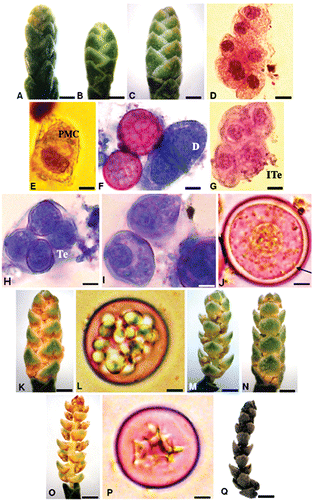Figures & data
Figure 1. Male phenological phases, microsporogenesis and pollen development ofC. sempervirens. A. Phenophase 1 (Starting date: 30/11/2006) – Bud cones. B, C. Phenophase 2 (Starting date: 10/12/2006) – Immature cones. D. Cluster of interconnected pollen mother cells (PMC) before meiosis. E. Isolated PMC with distinct nucleus. F. PMC at the dyad phase (D) showing equatorial division. G. Isobilateral tetrad (ITe) with four microspores. H. Tetrad (Te) enclosed in a common callose wall. I. Uninucleate free microspore. J. Early microspore maturation with conspicuous nucleus showing the intine formation (arrow). K. Phenophase 3 (Starting date: 12/02/2007) – Pre‐flowering cone showing pollen sacs between scales. L. Late microspore maturation with droplet inclusions as accumulated nutrients. M, N. Phenophase 4 (Starting date: 23/02/2007) – Blossoming cones showing basipetal (M) and acropetal (N) dehiscence. O. Phenophase 4 – Blossoming cone with completely opened scales and empty pollen sacs. P. Mature pollen grain showing a star‐like cytoplasm. Q. Phenophase 5 (Starting date: 25/03/2007) – Senescent brown cone with unfolded scales. Scale bars – 550 µm (A); 600 µm (B); 650 µm (C); 10 µm (D); 6 µm (E, H, P); 6.5 µm (F); 7 µm (G); 5 µm (I); 3 µm (J); 800 µm (K); 4 µm (L); 900 µm (M, N); 1 mm (O‐Q).

Table I. Dendrological data and total pollen production of Cupressus sempervirens in Tetouan (Morocco). (a)Cones/tree is calculated by multiplying the average number of cones/m2 by the total surface area average. (b)Total pollen/tree is obtained by multiplying the total cones/tree by the average number of pollen grains/cone.
Table II. Cone and pollen production in the nine studied trees: C/Tr – number of cones per tree; PG/C – number of pollen grains per cone; PG/Tr – number of pollen grains per tree. (a) Mean of three cones per tree.
Table III. Correlations between tree characteristics: Hc – height crown; Br/Tr – branches per tree; C/Tr – cones per tree; PG/Tr – pollen grains per tree; Br/m2 – branches per square meter. P<0.05
Figure 2. Factor analysis diagrams obtained by using 6 or 7 variables and 52 and 9 trees(selected for pollen grains estimation) of C. sempervirens respectively in (A) and (B) diagrams. Variables used: height crown (Hc), surface (S), radius (R), branches per tree (Br/Tr), cones per tree (C/Tr), branches per square meter (Br/m2 ) and pollen grains per tree (PG/Tr).
